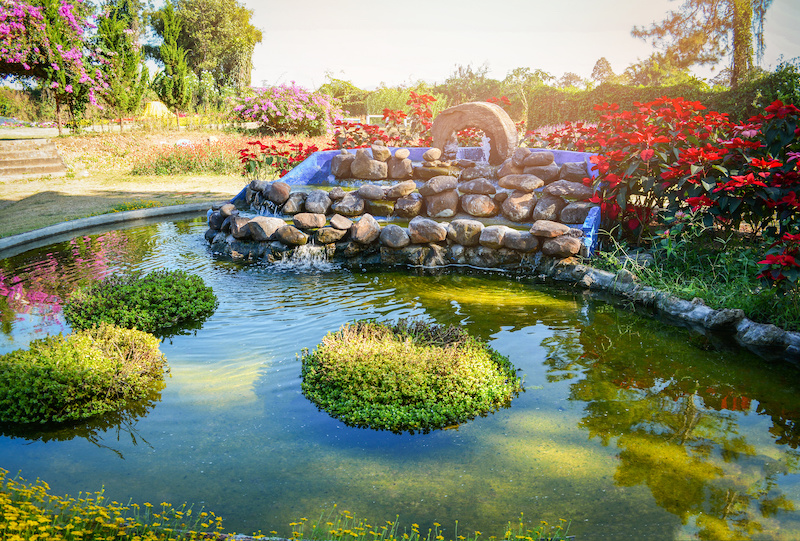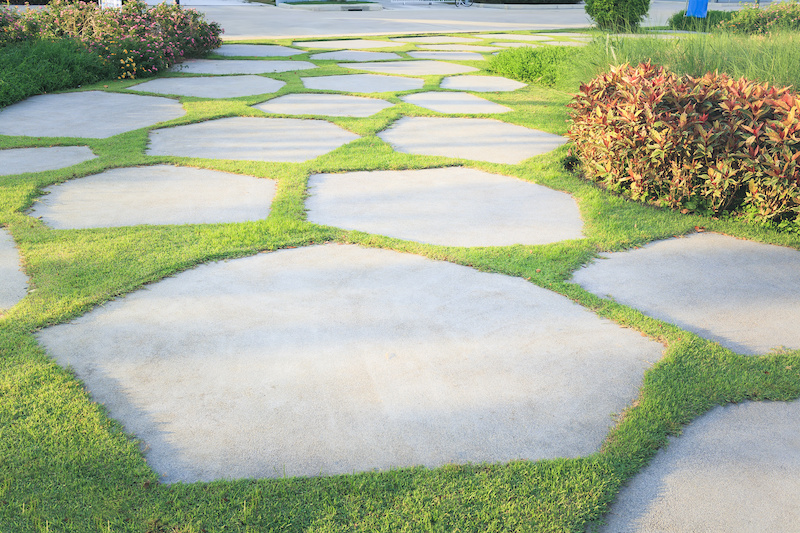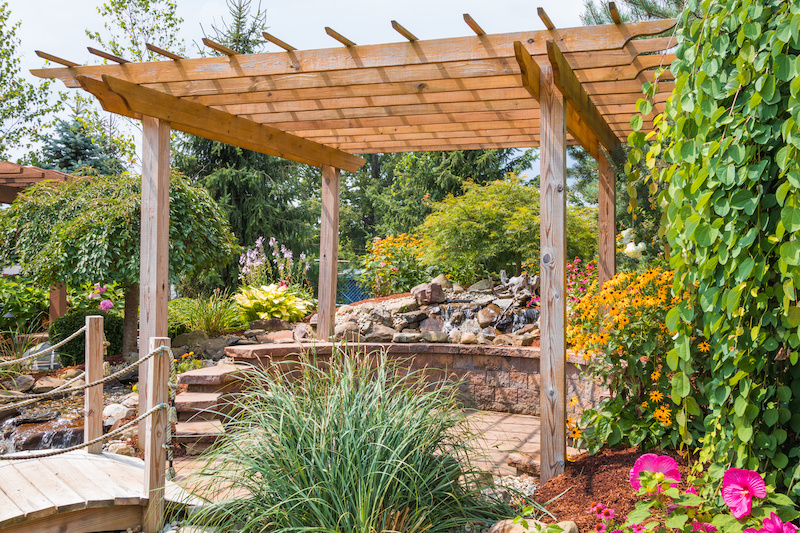Transforming your outdoor space is a dance between hardscaping and softscaping. The magic happens when you strike the right balance.
Hardscape elements, like patios or retaining walls, provide structure while softscape features breathe life into your garden. But how do we find that sweet spot?
Table Of Contents:
- Understanding the Balance between Hardscaping and Softscaping
- Design Principles for Integrating Hardscape and Softscape
- Exploring Different Hardscape Elements
- Choosing the Right Softscape Elements
- Enhancing Curb Appeal with Hardscape and Softscape Integration
- Environmental Considerations in Hardscaping and Softscaping
Understanding the Balance between Hardscaping and Softscaping
Hardscaping and softscaping are like two sides of a coin in landscape design. While hardscape refers to hard elements such as concrete, bricks, and stone, softscape includes living elements like plants and trees.
A well-designed outdoor space strikes an effective balance between these landscape elements.

The Interplay of Hardscape Elements with Softscape Features
To appreciate their interplay, imagine your garden landscaping as a painting. The hardscape structures – patios or retaining walls – serve as the frame.
On the other hand, vibrant annual plants or growing shrubs provide those strokes of color that make your canvas come alive.
Natural Stone versus Living Plants: Striking the Right Balance
The challenge lies in ensuring neither aspect overwhelms the other. An overabundance of inanimate objects can create a sterile environment, while too many living components may appear chaotic.
Incorporating Practical Purpose Alongside Ecological Balance
Focal points such as swimming pools not only add visual interest but also have a practical purpose by providing extra seating for outdoor gatherings.
However, don’t forget vertical spaces. Adding outdoor planters filled with ornamental grasses can bring life even to stark brick walls while keeping the ground intact.
Also, remember that both these features should co-exist harmoniously within your available outdoor area without crowding it.
Curb Appeal Boosts Property Values
Your home’s curb appeal isn’t just about aesthetics either; it significantly influences property values.
Walking paths, for instance, add a practical element while softscape landscaping around it enhances visual appeal.

Remember to incorporate hardscape and softscape features that complement each other as well as the overall architectural style of your home.
The Role of Landscape Professionals
If you’re thinking about installing a new deck, these improvements can really boost your home’s value. Before you start, it is prudent to plan and budget accordingly. Hiring a team of professionals who can cover all your bases will help ensure that all the elements fit together and that you can remain within your budget.
Creating a stunning outdoor space is all about balancing hardscaping and softscaping. Think of your garden as a painting, where concrete structures serve as frames and vibrant plants add color. Be mindful not to overwhelm with too many inanimate or living elements. Adding practical focal points like pools can enhance visual interest without crowding your space, ultimately boosting curb appeal and giving you an oasis right at home.
Design Principles for Integrating Hardscape and Softscape
To create a balanced outdoor living space, you need to integrate hardscaping elements with softscape features. This is more than just throwing together some pavers and plants; it’s about design ideas that blend the inanimate objects of your landscape with its growing components.
Creating Functional Spaces with Hardscapes
Hardscape structures like patios, retaining walls, or walking paths give shape to our outdoor spaces. But they’re not merely practical—they also add aesthetic value. For example, a natural stone path winding through a lush garden offers visual interest while serving the practical purpose of guiding guests around your property.
A well-placed retaining wall can serve as both an eye-catching focal point and a functional element that keeps the ground intact. Here are 42 Retaining Wall Ideas to Keep Your Garden Together. Just remember—too much hardscape increases runoff and may make your yard seem sterile.
Enhancing Aesthetics with Softscapes
The key to enhancing aesthetics lies within softscaping—the living elements in landscaping design such as grasses, shrubs, trees—and even annual plants. They soften hard edges created by common hardscape items like concrete or brickwork, making them integral parts of any outdoor area.
An array of colorful flowers alongside green foliage provides texture against rigid structures. Considerations of environmental effects should be made when selecting materials for both hard and soft landscapes.
Too much softscape, though, and you risk creating a jungle that obscures your home’s curb appeal. Maintaining the balance can be difficult.
Finding the Balance
Striking the right balance between hardscape and softscape elements is crucial for any successful landscape design. Consider both functional needs (like walking paths or extra seating) and aesthetic desires when planning your outdoor living spaces.
A thoughtful layout incorporates both hardscape and landscape, guiding visitors through the space while highlighting nature’s beauty. The path is not just a way to get from point A to B—it becomes part of the journey itself, offering scenic views at every turn.
It’s all about hitting that sweet spot. If you go overboard with either hardscapes or softscapes, it can throw the whole space off balance. Too much hardscaping could make your area feel sterile and uninviting, while an excess of softscaping might leave it feeling cluttered and untamed. So remember, achieving a harmonious outdoor space is a delicate dance between structure and life.
Exploring Different Hardscape Elements
Hardscaping serves a practical purpose, but it also lets us add personality to our outdoor spaces. Let’s start with retaining walls. These hardscaping elements are more than just stone or concrete barriers; they’re structures that keep your ground intact and reduce potential erosion.
Retaining walls can become the focal point of your garden, especially when combined with softscape features like growing shrubs or ornamental grasses. But remember, balance is key – too much hard structure without the contrast of living plants can create a sterile environment.
The Charm of Stone Pavers
Natural stone pavers offer another versatile option for hardscape design. With an array of shapes and colors available, you can create walking paths that meander through your landscape or lead directly to other hardscape features like swimming pools or an outdoor kitchen.
A well-placed path not only increases functionality but also adds aesthetic value by dividing space and providing visual interest. However, don’t forget vertical space – consider adding height with structures such as pergolas for extra seating areas beneath their shade.
The Calming Effect Of Water Features
Water features bring a unique dynamic to any landscaping design – the sound alone has a calming effect. A fountain surrounded by annual plants creates a striking centerpiece while offering an ecological balance between inanimate objects and living elements.
Ponds provide opportunities for more extensive plantings around their perimeters plus attracting local wildlife could be seen as contributing positively to environmental effects.
Making Room For Outdoor Kitchens
An outdoor kitchen is a fantastic hardscape feature for those who love to entertain. With the right design, it can increase your home’s curb appeal and property values.
You don’t need an expansive space – clever designs can fit into smaller yards too. Remember though, you’re not limited to just grills; think about incorporating pizza ovens or built-in coolers as well.
All these features can come together under a pergola, which enhances the outdoor seating area and shades from the elements. Hardscaping lets us tap into our creativity, transforming spaces in ways we never thought possible.
And don’t overlook the vertical dimension – think about adding pergolas. They not only enhance your outdoor space but also create extra seating areas, perfect for gatherings or quiet contemplation. All these elements together can transform any ordinary backyard into a functional and aesthetically pleasing haven.
Choosing the Right Softscape Elements
Selecting appropriate softscape elements like plants, shrubs, and trees can transform your outdoor space into a vibrant oasis. Your choices will largely depend on local climate conditions and personal preferences.
The Role of Climate in Softscape Selection
The local climate plays an essential role when it comes to choosing softscapes. It’s not just about picking visually appealing flora but also considering their ability to thrive in your area’s weather patterns.
For instance, if you’re living in SoCal with its Mediterranean-like climate, drought-tolerant plants are an excellent choice. They’ll not only survive under harsh sunlight but help conserve water as well.
You might want to consider drought-tolerant landscaping options. These include species such as California poppy or Blue Palo Verde that can withstand dry periods without compromising aesthetics.
Balancing Aesthetics and Practicality
A harmonious landscape isn’t solely about selecting pretty flowers; practical considerations matter too. The right mix of perennials (for year-round greenery) along with annuals (to add seasonal color bursts) creates visual interest throughout the year.
Maintaining Ecological Balance through Diversity
Incorporating diverse plant types helps maintain ecological balance while enhancing visual appeal. This means including a variety of trees for shade or privacy, shrubs for structural stability, or even ornamental grasses for texture variation.
Green building principles suggest using local species as they’re better adapted to the environment and require less maintenance.
The Magic of Softscapes: Constant Evolution
Softscape elements are like living art pieces; they change and evolve with time. Their growth patterns, seasonal transformations, or even their response to weather conditions add dynamic beauty to your landscape.
A well-planned softscape can also increase property values while providing a relaxing outdoor living space for you and your family. Just remember, these growing components need care like watering, pruning, and fertilizing. So make sure to take time for these tasks to keep your outdoor oasis looking its best.
When selecting softscape elements, climate and personal preference play a key role. Balance aesthetics with practicality by using perennials for year-round greenery and annuals for seasonal color. Include diverse plants to maintain ecological balance while enhancing visual appeal. Remember, your landscape is living art that evolves over time, requiring care like watering and pruning.
Enhancing Curb Appeal with Hardscape and Softscape Integration
Your outdoor space can be a beautiful extension of your home. But to create an inviting area, you need more than just greenery.
The Magic Blend: Hard Meets Soft
Hardscaping refers to the inanimate objects like retaining walls, patios, or walking paths that give structure to your landscape. On the other hand, softscaping involves growing components – think flowers, shrubs, or ornamental grasses. The secret sauce? Balancing these complete opposites for a harmonious look.
You may have seen those yards dominated by concrete structures that seem sterile and unwelcoming despite their clean lines. That’s because they lack balance – hardscape elements without living ones can feel cold and uninviting. Sustainability is key, so it’s important not only for aesthetics but also for ecological balance.
Incorporating Hardscapes Wisely
A good starting point could be natural stone pathways leading up to your front door as focal points that immediately catch attention while serving practical purposes, too. Think about how much better it would be if instead of staring at blank walls around the property line; there were beautiful retaining walls.
Add some seating areas maybe? How about creating extra spaces with functional hardscaping elements such as an outdoor kitchen or fire pit?Not only will this increase useable living space but potentially enhance property values too.
Don’t Forget the Softscape
The soft elements of your landscape are what bring life to your outdoor space. The right blend of perennials, annual plants, and trees can transform a sterile environment into a vibrant living area.
Keep your yard lush but not overly dense. Remember to balance by incorporating vertical spaces – think climbing vines or hanging planters. Consider using drought-resistant plants. Not only will they add beauty, but also keep your water bills in check.
Turn your outdoor space into a stunning extension of your home by striking the right balance between hardscaping and softscaping. Retaining walls, patios or pathways can add structure while flowers, shrubs, and ornamental grasses breathe life into it. Add practical elements like natural stone paths or an outdoor kitchen for increased appeal and value. Remember to keep things lively with the perfect mix of functional features and greenery to create a space that truly feels like home.
Environmental Considerations in Hardscaping and Softscaping
Have we ever paused to contemplate the consequences of our captivating landscaping designs on nature in our area? In this section, we’re going to dig deeper into how different hardscape materials can affect environmental factors such as potential erosion.
The Impact of Hardscaping Materials
Different hardscape materials can significantly influence your outdoor space’s ecological balance. For instance, porous elements like natural stone allow water to soak in which helps keep the ground intact. On the other hand, using more impermeable surfaces like concrete pavement could lead to increased runoff.
This runoff not only depletes soil nutrients but also carries pollutants that harm aquatic life downstream. Hence, choosing permeable pavers or gravel for walkways is a sustainable choice that allows rainwater infiltration while still providing hard-wearing paths through your garden landscaping.
A Positive Influence: The Role of Softscaping
While some aspects of hardscaping may pose challenges from an environmental standpoint, softscape features bring numerous benefits. Living plants add much-needed oxygen back into our air and create habitats for beneficial insects and birds; they are integral parts of maintaining an ecological balance within urban spaces.
Incorporating annual plants and ornamental grasses might be more than just pretty additions – these living components help retain moisture levels in soil, thus reducing dependence on watering systems which ultimately conserve water resources.
Check out this guide for insights on green building movement principles applied to landscape design.
Striking a Balance
The objective is to find a harmony between hardscape and softscape features. The beauty of your outdoor area doesn’t have to come at the expense of environmental responsibility.
You can start by using more natural materials like stone or wood for your hardscaping structures instead of concrete, which significantly reduces CO2 emissions associated with its production process. Similarly, consider incorporating native plants into your softscaping design; they are better adapted to local climate conditions and typically require less water than non-native species.
Embrace eco-friendly landscaping by thoughtfully selecting hardscape materials and incorporating beneficial softscape features. Opt for permeable pavers or gravel to minimize runoff, and balance this with native plants that conserve water resources while enhancing local ecology. Remember, the charm of your outdoor space needn’t compromise environmental responsibility.
FAQs in Relation to Hardscaping and Softscaping
What is an example of softscaping?
Softscaping includes the living elements in landscaping. Examples are trees, shrubs, flowers, grasses, and vines.
What does softscape mean in landscaping?
In landscaping terms, a ‘softscape’ refers to all biological or living parts like plants that add color and texture to your yard.
What are the landscape elements hardscape and softscape?
‘Hardscape’ refers to non-living things like patios, walls, or pathways made from stone or wood. ‘Softscape’ means all living stuff such as plants and trees.
What is the difference between hardscaping and landscaping?
Hardscaping focuses on constructing solid structures in your outdoor space while landscaping encompasses both hard (like walkways) and soft (like plants) aspects of garden design.
Conclusion
Mastering the balance between hardscaping and softscaping is key to transforming your outdoor space. It’s about creating harmony, functionality, and aesthetic appeal.
Hardscape elements provide structure. They’re the retaining walls, patios, and walking paths that make an outdoor area functional and organized.
Softscape features bring life. The trees, shrubs, and flowers – they add color and soften the hardness of stone or concrete.
Picking suitable materials for hardscapes takes environmental considerations into account while selecting plants for softscapes depends on climate conditions.
In essence: blend hard with soft; organize with living elements; consider the environment in material choice; and always keep climate in mind when choosing plants. Remember these takeaways as you create a harmonious blend of hardscaping and softscaping in your landscape design journey!
If you want to take your backyard to the next level, contact us at MGC Construction & Decks today! Our team has decades of experience in the industry, and we offer a wide range of services. Here are some examples of our work for you to feast your eyes on.

